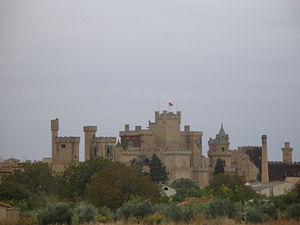
Palacio Real de Olite
Encyclopedia

Olite
Olite is a town and municipality located in the province and autonomous community of Navarre, northern Spain....
. It was one of the seat of the Court of the Kingdom of Navarre
Kingdom of Navarre
The Kingdom of Navarre , originally the Kingdom of Pamplona, was a European kingdom which occupied lands on either side of the Pyrenees alongside the Atlantic Ocean....
, since the reign of Charles III "the Noble"
Charles III of Navarre
Charles III , called the Noble, was King of Navarre from 1387 to his death and Count of Évreux from 1387 to 1404, when he exchanged it for the title Duke of Nemours...
.


Charles III of Navarre
Charles III , called the Noble, was King of Navarre from 1387 to his death and Count of Évreux from 1387 to 1404, when he exchanged it for the title Duke of Nemours...
who in the 15th century began the extension of the former castle, leading to the Palace of the Kings of Navarre. Although almost everyone calls it "castle", is right to refer to it as "palace", as it is a building of courtly character, where the residential aspects prevailed over the military (defense).
One of its main attractions is the apparent disorder of its design. This is because its construction never faced such a project "set", having the final result to the ongoing expansion work and reforms that followed for centuries, although most of the works were made between the late 14th century and early 15th century. The then King of Navarre, Charles III "The Noble"
Charles III of Navarre
Charles III , called the Noble, was King of Navarre from 1387 to his death and Count of Évreux from 1387 to 1404, when he exchanged it for the title Duke of Nemours...
, decided to convert the existing palace in permanent royal seat and give it every the own ornament.
The set consists of its rooms, gardens and moats, surrounded by high walls and topped by numerous towers, give a spectacular and magical figure. In its time, came to be regarded as one of the most beautiful in Europe. It can clearly differentiate two areas: the Old Palace, become in Parador Nacional de Turismo, and the New Palace. After the invasion of Navarre
Kingdom of Navarre
The Kingdom of Navarre , originally the Kingdom of Pamplona, was a European kingdom which occupied lands on either side of the Pyrenees alongside the Atlantic Ocean....
in 1512 by the Crown of Castile
Crown of Castile
The Crown of Castile was a medieval and modern state in the Iberian Peninsula that formed in 1230 as a result of the third and definitive union of the crowns and parliaments of the kingdoms of Castile and León upon the accession of the then King Ferdinand III of Castile to the vacant Leonese throne...
and Aragon
Crown of Aragon
The Crown of Aragon Corona d'Aragón Corona d'Aragó Corona Aragonum controlling a large portion of the present-day eastern Spain and southeastern France, as well as some of the major islands and mainland possessions stretching across the Mediterranean as far as Greece...
unified, began the deterioration of the palace, as it was only used by the viceroys as residence sporadic. The state of abandonment in which was immersed in the palace it was progressively deteriorating. This process culminated with the fire directed by the guerriller Espoz y Mina
Francisco Espoz y Mina
Francisco Espoz y Mina was a Spanish guerrilla leader and general.He was born at Idocin in Navarre. His father, Juan Esteban Espoz y Mina, and his mother, Maria Teresa Hundain y Ardaiz, belonged to the class of yeomen. Mina remained working on the small family inheritance until 1808...
during the Peninsular War
Peninsular War
The Peninsular War was a war between France and the allied powers of Spain, the United Kingdom, and Portugal for control of the Iberian Peninsula during the Napoleonic Wars. The war began when French and Spanish armies crossed Spain and invaded Portugal in 1807. Then, in 1808, France turned on its...
(1813), fearing that on it was fortified the French troops of Napoleon.
Sources

- Mariano Carlos Solano y Gálvez, Marqués de Monsalud "El Palacio Real de Olite", Boletín de la Real Academia de la Historia, 49 (1906), pp. 435–447.
External links
- Castillo palacio de Olite at CastillosNet
- Palacio de Olite at Guiarte Navarra
- Palacio Real de Olite at Navarra.es
- Castillo-Palacio Real de Olite (unofficial site)
- Fotos del Castillo de Olite (Navarra) at EuroResidentes
- Belgian mayor had inappropriate encounter (at LifeToday)

